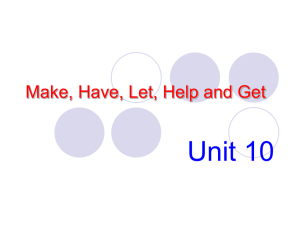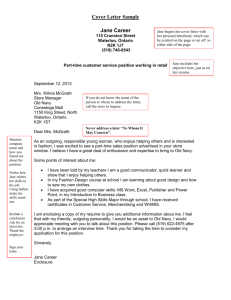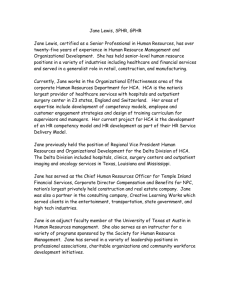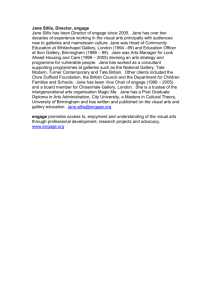The Language of Slavery in Jane Eyre
advertisement
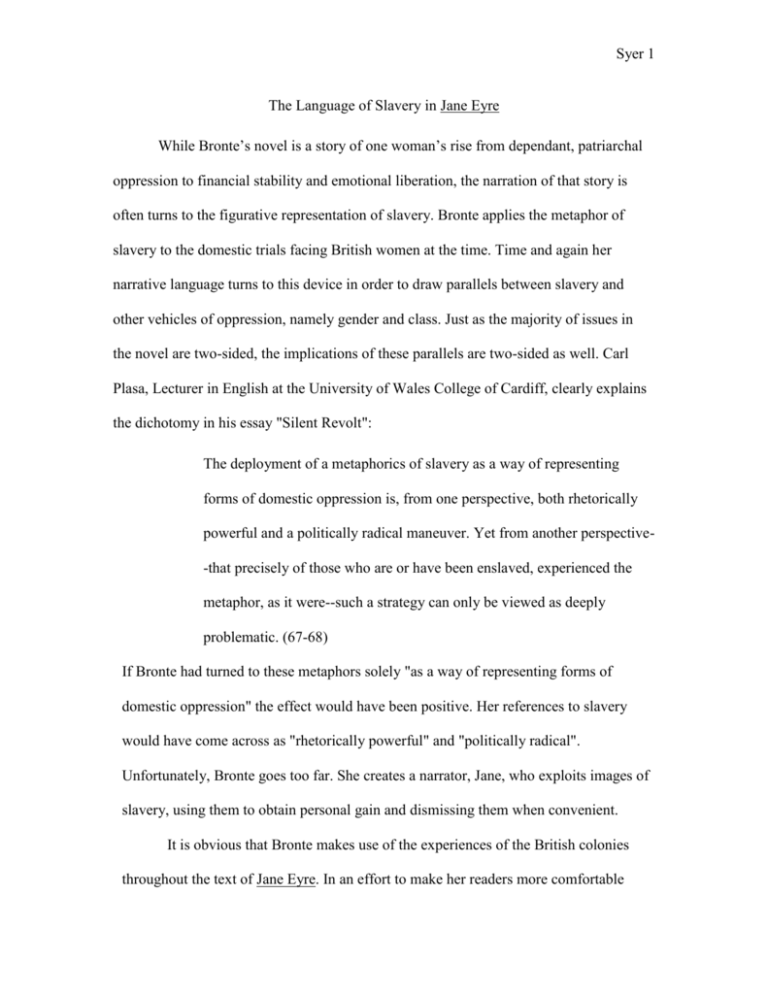
Syer 1 The Language of Slavery in Jane Eyre While Bronte’s novel is a story of one woman’s rise from dependant, patriarchal oppression to financial stability and emotional liberation, the narration of that story is often turns to the figurative representation of slavery. Bronte applies the metaphor of slavery to the domestic trials facing British women at the time. Time and again her narrative language turns to this device in order to draw parallels between slavery and other vehicles of oppression, namely gender and class. Just as the majority of issues in the novel are two-sided, the implications of these parallels are two-sided as well. Carl Plasa, Lecturer in English at the University of Wales College of Cardiff, clearly explains the dichotomy in his essay "Silent Revolt": The deployment of a metaphorics of slavery as a way of representing forms of domestic oppression is, from one perspective, both rhetorically powerful and a politically radical maneuver. Yet from another perspective-that precisely of those who are or have been enslaved, experienced the metaphor, as it were--such a strategy can only be viewed as deeply problematic. (67-68) If Bronte had turned to these metaphors solely "as a way of representing forms of domestic oppression" the effect would have been positive. Her references to slavery would have come across as "rhetorically powerful" and "politically radical". Unfortunately, Bronte goes too far. She creates a narrator, Jane, who exploits images of slavery, using them to obtain personal gain and dismissing them when convenient. It is obvious that Bronte makes use of the experiences of the British colonies throughout the text of Jane Eyre. In an effort to make her readers more comfortable Syer 2 Bronte chooses not to address the issue of British dominance and colonization directly. Throughout the text Jane conjures images of slavery from the Far East, conveniently failing to mention Caribbean slavery. During Rochester’s courtship of Jane she likens him to a sultan, saying: "The eastern allusion bit me again: ‘I’ll not stand you an inch in the stead of a seraglio,’ I said; ‘so don’t consider me an equivalent for one; if you have a fancy for anything in that line, away with you, sir, to the bazaars of Stamboul without delay; and lay out in extensive slave-purchases some of that spare cash you seem at a loss to spend satisfactorily here" (267). Jane is not reluctant to speak of "slavepurchases" if they are in Stamboul rather than Jamaica. Even with the integral connection the story has to Jamaica, Jane refuses to make a direct reference to the slave trade in that area. Rochester goes on to make clear references to Jane as being his slave, "it is your time now, little tyrant, but it will be mine presently: and when once I have fairly seized you, to have and to hold, I’ll just--figuratively speaking--attach you to a chain like this" (269; ch. 24). By turning to the East, Bronte is incorporating the sexual dominance that goes hand in hand with slavery in that region at that time. This allows her to make a strong point and still suits her purpose better than the image of British colonization in the Caribbean, which carries more abrasive connotations. If Bronte had wanted to speak out in the name of the oppressed slaves of Jamaica she would have cast Bertha Mason in a better light. Bertha is the most obvious character used to represent colonialism in the Caribbean. She is ’Janes competition because, even though she is supposedly insane, she is Rochester’s wife. Bronte allows white, middle-class Jane to overcome the challenge of Bertha by tainting her character with negatively viewed images of rebellious slaves. Bertha is from Jamaica and even Syer 3 though it is assumed that for Rochester to marry Bertha she must have been a member of the white, upper-class minority on the island, Bronte is purposely vague when it comes to the question of Bertha’s race. She describes Bertha as Creole. This is problematic because, as Plasa explains: "The term can refer equally to persons born and naturalized in the West Indies of either European or African descent having, as the OED stresses, ‘no connotation of color’" (65). However, when Bertha breaks out of the attic and comes to rip Jane’s veil in two, Jane later describes her to Rochester as having, "a discoloured face-- it was a savage face. I wish I could forget the roll of the red eyes and the fearful blackened inflation of the lineaments! [. . . .] This, sir, was purple: the lips were swelled and dark; the brow furrowed; the black eyebrows wildly raised over the blood-shot eyes" (281; ch. 25). Clearly, Bertha is materializing in the text not as a white upper-class citizen of Jamaica, but as a slave. Jane’s description of her is in line with popular stereotypes of the nineteenth century; the "discoloured face" and "lips [that] were swelled," as well as the redness in her eyes that implies drunkenness (Meyer 152). Instead of imparting on Jane feelings of sympathy for Bertha, as well as for the enslaved people she represents, Bertha is likened to the Jamaican anti-slavery rebels, the Maroons. The Maroons were feared by the British; they were seen as a threat which needed to be confined and eliminated (Burns 278). The Maroons were sheltered by the rugged interior of Jamaica, making it hard for the British to control them. There were several revolts by the Maroons in which they committed acts of murder and arson. Considering this, it is easy to see what Jane means when she says of Bertha: "What crime was this, that lived incarnate in this sequestered mansion, and could neither be expelled nor subdued by the owner? - What mystery, that broke out, now in fire and Syer 4 now in blood, at the deadliest hours of the night?" (211; ch. 20). Susan L. Meyer adds in her essay "Colonialism and the Figurative Strategy of Jane Eyre:" "The language of this passage strongly evokes that used to describe slave uprisings in the British West Indies, where slaves used fires both to destroy property and to signal to each other that an uprising was taking place" (152-153). In addition, Spanish Town, formerly Villa de la Vega, was the Spanish capital where the Spaniards released the very slaves who became the Maroons after the British invasion of the island. The history of Spanish Town provides even further evidence of the intended connection of Bertha to the Maroons, since Rochester refers to her as, "the boast of Spanish Town for her beauty" (301; ch. 27). The way Rochester has brought Bertha to Thornfield and caged her in the attic just reinforces the idea that Bertha is a figure of Jamaican slavery. The treatment of Bertha in the text serves as a prime example of Bronte’s selectivity of sympathy for oppressed people. Bronte creates in Jane a character who speaks for the oppressed when it is convenient and beneficial for herself; when it is clearly beneficial for Jane to become the oppressor, she assumes the position fearlessly in order to make sure Bertha is no longer a threat to her relationship with Rochester. Another case of Bronte’s exploitation of slavery is Jane’s representation of herself as being figuratively enslaved by her gender and class. Bertha acts as a more literal representation of slavery, and still receives no sympathy from Jane. One would think that if Jane feels so tyrannized, then she would naturally be able to relate to Bertha, and even desire to console her. This is far from the case. Even though those who surround Jane are cast into the role of slave-master time and again, Jane recognizes no parallel between Bertha and herself. This suggests that Jane’s expressions of feeling Syer 5 enslaved are nothing more than a ploy to enlist sympathy for herself; she does not truly feel the pangs of oppression. Right from the start Jane wants her reader to think that she can relate to the enslaved. While she is living at Gateshead she envisions her cousin John Reed as being "like a slave-driver" (23; ch. 1). The parallel of her cousin to a "slave-driver" is obviously intended to make her reader feel sorry for her. In this instance, Jane tells us she had "drawn parallels in silence," (23; ch. 1) and these parallels continue throughout the book. After being punished for striking out against her "slave-driver," Jane carries the image even further, saying, "the mood of the revolted slave was still bracing me with its bitter vigour" (27; ch. 1). She goes to lengths in the first few chapters to distinguish herself as a victim, an outsider. When Jane is feeling sorry for herself in the red-room, she says, "how could she [Mrs. Reed] really like an interloper not of her race" (28; ch. 1). This is an exaggerated attempt to cast herself as being, not only an outcast, but actually racially connected to the enslaved people of color. Jane may not be Mrs. Reed’s child, but she is her niece. After this, when she is at Lowood school, we see her return to this inflated analogy of herself to a slave. Mr. Brocklehurst forces her to sit on a chair in the middle of the room; when Helen Burns passes her she says, "It was as if a martyr, a hero, had passed a slave or victim, and imparted strength in the transit" (76; ch. 7). The way in which Jane sets up this scenario is clearly an effort to evoke compassion from the reader. By turning Helen into a savior figure who "imparted strength" to Jane, Bronte is saying that Jane has been weakened by her tormentor Mr. Brocklehurst needs to be freed from his oppressive powers. This is overly dramatic. Later, while still at Lowood, Jane’s cries resemble very closely those of a slave, "I desired liberty; for liberty I gasped; for liberty I uttered a prayer" (93; ch. Syer 6 10). How could Jane possibly be so desperate for "liberty," she is allowed to roam the countryside surrounding the school and she has obtained a teaching position there. Jane’s distress pales in comparison to Bertha, who has been locked in an attic for years. When Jane finally acts on her desire for liberty she ends up in a situation where, once again, she feels she can relate to slavery. At Thornfield, the language of Rochester’s courtship of Jane brings images of slavery, particularly Jane’s rejection of being enslaved. Reflecting upon the night of his proposal to Jane, Rochester tells her, "You glowed in the cool moonlight last night, when you mutinied against fate, and claimed your rank as my equal" (261; ch. 24). Once more the reader is told that Jane’s "fate" is something terrible enough that it necessitates being "mutinied against." To place in comparison to Bertha again, Jane’s demand for equality is cast in a positive light, but Bertha’s outbreaks from the attic are turned into frightful events. The slave analogy is thrown out again when Jane and Rochester are heading home from shopping, Jane tells us, "He [Rochester] smiled; and I thought his smile was such as a sultan might, in a blissful and fond moment, bestow on a slave his gold and gems had enriched: I crushed his hand, which was ever hunting mine, vigorously, and thrust it back to him" (267; ch. 24). This follows the repetitive pattern of evoking feelings of concern for Jane. Even during her courtship with Rochester, the man of her dreams, she feels the need to victimize herself. She practically turns her fiancee’s natural passion and love into a crime against her. Eventually Jane flees from her life with Rochester, only to arrive in yet another position that can be likened to slavery. Jane’s relationship with St. John again employs the figurative language of slavery. While residing at Moor House Jane explains that: "I Syer 7 never in my life have known any medium in my dealings with positive, hard characters, antagonistic to my own, between absolute submission and determined revolt [. . .] and as neither present circumstances warranted, nor my present mood inclined me to mutiny, I observed careful obedience to St. John’s directions" (391; ch. 34). It is undeniable by this point that Jane is going out of her way to make her life appear more tragic than it really is. Jane hasn’t been offered the best opportunities in life, but she has never failed to follow her desires. When Jane has determined to do something, she has always been able to accomplish it. Earlier, when St. John has kissed Jane good-night, she claims, "I felt as if this kiss were a seal affixed to my fetters" (389; ch. 34). What fetters? Jane is fettered to nothing. She has proved this with every decisive action thus far. Yet another example of Jane using slavery to her advantage is her wealth. The wealth that frees Jane from domestic oppression is obtained through the enslavement of others. Jane never expresses feelings of reluctance towards the wealth due to its origins; nor does it ever occur to Jane that her wealth comes at the expense of others’ freedom. Jane inherits her wealth from her uncle John in Madeira; he obtained it from the Jamaican wine industry, working with Bertha’s brother. Jane then feels that all she needs to do is distribute her wealth and she will have done her part in righting the wrongs imposed on the lower-middle class. She will then be able to save her sisters from "slaving among strangers," "penniless" (379; ch. 33). But Jane’s solution only reaches so far, Meyer clearly states the problem: "The plot of Jane Eyre works toward a redistribution of power and wealth, equalization and an end to oppression just as Jane herself does, but its utopia remains partial; its ‘revolution’ improves only the lot of the Syer 8 middle class, closing out both the working class and those from whom the figure of ‘slavery’ has been appropriated in the first place" (159). It appears that throughout the novel Jane is reacting against the oppression she faces. The reader is led to believe that Jane wishes to obtain a more level playing field for anyone in her situation. However, when all is said and done, it becomes clear that Jane is not fighting for equality across the board; her fight is selective. We see the difference between Jane and the servants time and again, for example, Jane is allowed to attend the gatherings at Thornfield and the servants are not. Throughout the book she wishes to secure a middle-class status; she draws clear lines between herself and those working under her. This is very ironic given the purported theme of "a redistribution of power and wealth." Bronte obviously pulls a wealth of her material from ideas surrounding colonialism. She uses these ideas and images to suit her changing purposes, without regard for the ramifications of being inconsistent. Jane cannot be a speaker for the subjugated masses, when her vision excludes those who are inconvenient to embrace, such as Bertha. Ultimately, even though her troping of the language of slavery is problematic, she creates through her novel, as Meyers says in her essay, "a fascinating example of the associations-- and dissociations-- between a resistance to the ideology of male domination and a resistance to the ideology of colonial domination" (162). Syer 9 Works Cited Bronte, Charlotte. Jane Eyre. 1848. Ed. Beth Newman. Boston: Bedford/St. Martin’s, 1996. Burns, Sir Alan. History of the British West Indies. London: Allen & Unwin, 1965. Meyer, Susan. "From ‘Colonialism and the Figurative Strategy of Jane Eyre.’" PostColonial Theory and English Literature: A Reader. Ed. Peter Childs. Edinburgh: Edinburgh UP, 1999. 149-163. Plasa, Carl. "Silent Revolt: Slavery and the Politics of Metaphor in Jane Eyre." The Discourse of Slavery. Ed. Carl Plasa and Betty J. Ring. London: Routledge, 1994. 64-93. Syer, Honor. “The Language of Slavery in Jane Eyre” Charlotte’s Web: A Hypertext on Charlotte Bronte's Jane Eyre. At University of Michigan-Dearborn. Winter 2005. 7 Mar. 2006 <http://www.umd.umich.edu/casl/hum/eng/classes/434/charweb/syer2.htm>

